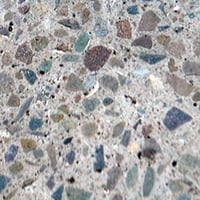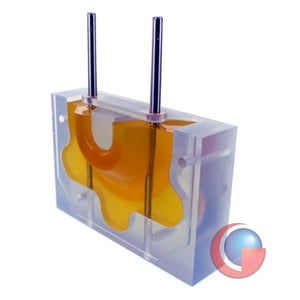Composites are changing the world we live in. From the Stone Age, to the Bronze Age, to the Iron Age, our civilization’s history has been defined by the materials we use. In the past, humans reshaped the raw materials they discovered in nature to create the items they needed. In our modern age we have moved beyond found objects, and have developed the technology to produce new materials, whose very make up is engineered specifically to fit the task at hand.
These composite materials deliver superior results compared to traditional metal, rubber, or even basic plastic parts. The advantages new composites offer however, is not limited to increasing the strength of existing components, but also now allow designers and engineers to rethink almost every structure humans produce.
What are Composites?
Composite materials combine two or more basic (constituent) materials, each having different characteristics, to produce a new material that is usually designed to have superior qualities compared to existing materials. The constituent materials of composites remain distinct elements within the composite, which makes composite materials different from a material which is simply a mixture of ingredients.
 One common example of a composite material is concrete, whose basic materials are loose stones and cement. The basic (constituent) materials of a composite are often described as being either the Matrix material or the Reinforcement material. The Matrix material is the binding agent that holds everything together. The Reinforcement material is the additional element that gives special mechanical and physical properties to the composite. Cement is the Matrix material of concrete, and the crushed stone is the Reinforcement material that adds strength. Note that “reinforced concrete” uses steel reinforcing bars (rebar), as an additional material to further improve the tensile strength of the cement matrix.
One common example of a composite material is concrete, whose basic materials are loose stones and cement. The basic (constituent) materials of a composite are often described as being either the Matrix material or the Reinforcement material. The Matrix material is the binding agent that holds everything together. The Reinforcement material is the additional element that gives special mechanical and physical properties to the composite. Cement is the Matrix material of concrete, and the crushed stone is the Reinforcement material that adds strength. Note that “reinforced concrete” uses steel reinforcing bars (rebar), as an additional material to further improve the tensile strength of the cement matrix.
Polymer Matrix Composites
Polymer Matrix Composites combine resins and epoxies with reinforcing fibers or minerals to create specialized materials. Designing customized composite materials involves choosing the right polymer type (polyester, vinyl ester, epoxy, etc.), and the right reinforcing material, followed by engineering the proper mix. Brandonite® is a good example of a well known Polymer Matrix Composite. Brandonite® is a family of composite materials, which can be engineered to fit a wide range of applications. By introducing different reinforcing additives into the Brandonite®, such as: carbon-fiber, fiberglass, S-glass, glass/plastic microspheres, or even metallic powders, Brandonite® can be made tough-as-steel or softer than rubber.

In addition to using the Brandonite® composites to create replacement parts, other unique composites can be created to introduce new features that are not possible with traditional materials. For example, Brandonite® can be enhanced to create a self-lubricating part that does not require oil or other lubricants, as a metal part does.
 Medical composites are also advancing at a rapid rate. Not only are huge advances being made in engineering prosthetics and devices, but composites are used to prevent disease. For example, composites can make antimicrobial coverings for medical devices, by infusing a base polymer with a nanosilver antibacterial substance. This special matrix can then compounded with FDA-approved fibers, without degrading the structural performance of the end-product. The infused silver remains suspended throughout the entirety of the composite material, slowly extracting over a period of time via the surface of the material. This process makes the composite not only immensely strong and durable, but also inherently anti-microbial.
Medical composites are also advancing at a rapid rate. Not only are huge advances being made in engineering prosthetics and devices, but composites are used to prevent disease. For example, composites can make antimicrobial coverings for medical devices, by infusing a base polymer with a nanosilver antibacterial substance. This special matrix can then compounded with FDA-approved fibers, without degrading the structural performance of the end-product. The infused silver remains suspended throughout the entirety of the composite material, slowly extracting over a period of time via the surface of the material. This process makes the composite not only immensely strong and durable, but also inherently anti-microbial.
There is no doubt that composites will continue to change the world in ever astounding ways. As new construction composites are introduced, we can expect to see great design changes to our houses and cars, whose form and function will evolve beyond today's standards. Additives to composite materials might also extend the functionality of the clothes we wear, and may even result in "Smart Textiles" that enable a link between fabric and tech devices. New "self-healing" soft-matter composite material might even be able to repair itself after extreme mechanical damage, mimicking the abilities of natural organisms.The new Composite Age is just beginning, and it’s reshaping our world in radically innovative ways.
Rethink your Existing Product or New Project
Globe has a team of engineers and chemists that can assess your needs and creatively design new parts, or redesign replacement parts, using the latest techniques and composite materials to radically improve performance for your company. Globe is well known for its ability to quickly produce functional prototypes. Rethink your next project and design it with composites that go beyond traditional materials to reduce costs, increase reliability or radically improve performance. If your existing parts made of metal, plastic or rubber fails, leaving you with time-consuming and costly problems, contact Globe Composite Solutions.



